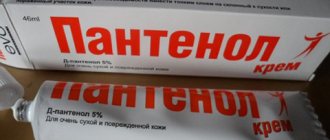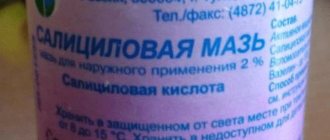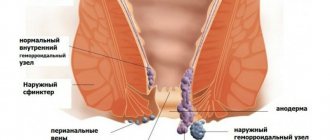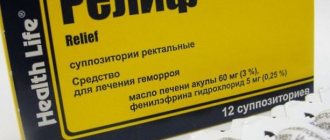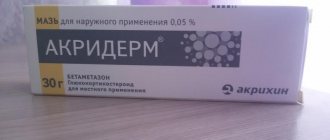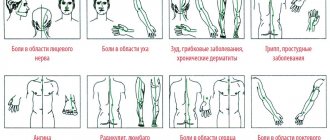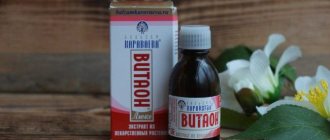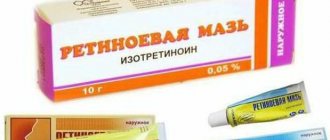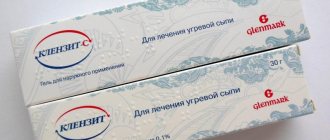Dexpanthenol is a drug with anti-inflammatory and regenerative effects. This product contains B vitamins and many other beneficial substances that have a beneficial effect on the human body.
The drug, due to its ability to penetrate many layers of the skin, shows high results in treatment.
In the given summary you will get acquainted with the drug Dexpanthenol, learn about its properties, as well as contraindications to the use of this drug.
Compound similarities
Dexpanthenol ointment has the following composition:
- active substance – dexpanthenol;
- additional components - petroleum jelly, almond oil, anhydrous lanolin, water, liquid paraffin, white beeswax, cetostearyl alcohol.
In addition to the active ingredient dexpanthenol, the gel contains glycerol, dimexide, water, ethyl alcohol, carbomer, diethanolamine.
The spray contains dexpanthenol and additional components such as natural sea salt, dipotassium hydrogen phosphate, potassium hydrogen phosphate, and purified water.
In addition to dexpanthenol, the solution includes a solution of sodium chloride 0.5%, dipotassium hydrogen phosphate, potassium dihydrogen phosphate and water for injection.
Another popular form of release is Dexpanthenol E cream. In addition to dexpanthenol, it contains α-tocopheryl acetate as an active component. Additional substances: white soft paraffin, cetostearyl alcohol, macrogolglycerol hydroxystearate, diethanolamine, purified water, liquid paraffin, macrogol cetostearyl ether, stearic acid, benzyl alcohol.
Both drugs contain the same active ingredient – dexpanthenol (5%).
The mechanism of action of these regenerating agents is based on the property of the active component (Dexpanthenol) to be converted into pantothenic acid, stimulating acetylation in the cellular structures of the epidermis. Pantothenic acid is a B vitamin, a coenzyme A enzyme that is easily soluble in water.
- regeneration of the epidermis;
- normalization of metabolism in skin cells;
- stimulation of fibroblast division;
- acceleration of mitosis;
- reduction of swelling and itching;
- moisturizing the stratum corneum of the epidermis.
- increasing the strength of collagen fibers.
The drugs have the same indications:
- burns;
- cuts, abrasions;
- dry skin;
- dermatitis (including diaper dermatitis);
- cracks in the nipples of the mammary glands;
- diaper rash;
- boils, trophic ulcers;
- anal fissures;
- cervical erosion;
- bedsores.
D-Panthenol has the following indications: burns, cuts, abrasions.
These products are also recommended to stimulate recovery processes after skin grafting operations.
| Excipient in the ointment | Bepanten | D-Panthenol |
| Protegin X | ||
| Cetyl alcohol | ||
| Stearyl alcohol | ||
| Beeswax white | ||
| Lanolin | ||
| Paraffin soft white | ||
| Almond oil | ||
| Liquid paraffin | ||
| Distilled water | ||
| Vaseline white | ||
| Vaseline oil | ||
| Myristic acid isopropyl ester | ||
| Cholesterol | ||
| Methyl and propyl esters of p-hydroxybenzoic acid |
The similarity in the composition of these drugs released in the form of an ointment is limited to the following additional components:
- lanolin;
- distilled water.
| Excipients in the cream | Bepanten | D-Panthenol |
| DL-pantolactone | ||
| Phenoxyethanol | ||
| Potassium cetyl phosphate (amphisol K) | ||
| Cetyl alcohol | ||
| Stearyl alcohol | ||
| Lanolin | ||
| Isopropyl myristate | ||
| Propylene glycol | ||
| Purified water | ||
| Ketomacrogol 1000 | ||
| Cetearyl octanoate | ||
| Dimethicone | ||
| Glyceryl monostearate | ||
| Methyl and propyl esters of p-hydroxybenzoic acid | ||
| Flavor "Seaside" |
These drugs, released in the form of a cream, have the following identical auxiliary components in the composition:
- propylene glycol;
- purified water;
- cetyl alcohol.
Due to its oily structure, the ointment is used to protect exposed skin (hands, face) from wind and cold.
To understand the difference between D-panthenol ointment and cream, you need to know the basic differences between these two dosage forms. The main difference is the basis.
| Ointment | Cream |
| Does not contain water | Contains water |
| Creates a greenhouse effect after application | Pleasantly cools |
| Has a systemic effect, penetrating the bloodstream | Remains on the upper layers of the skin, has a local effect |
| Leaves greasy marks and needs to be removed from the skin | Absorbs and leaves no greasy residue |
| Represents only medical drugs | Can be both a medical drug and a cosmetic product |
The base for the ointment always includes fats, there is no water in it. Due to this, after application to the damaged area, a greenhouse effect is created, which leads to active and deep absorption of medicinal components. Therefore, the ointment has a systemic effect and usually has more contraindications if it contains toxic components.
The base for the cream is not so greasy. It contains water. The light emulsion practically does not penetrate the bloodstream and has a local, superficial effect. In addition, due to the soda content, a pleasant cooling effect is created.
The base also affects ease of use. The cream can be applied at any time, it is not noticeable on the skin and does not require rinsing. The ointment has a greasy base, it is not completely absorbed and remains on the skin. Some time after application it needs to be washed off.
An important difference is that the ointment is an exclusively medicinal form of release. When buying it, you can be sure of the content of active ingredients. In this case, you need to carefully look at contraindications and possible adverse reactions.
In what cases is the use of ointment indicated and contraindicated?
If a person has damaged skin, the doctor may recommend applying Dexpanthenol ointment. Indications for the use of this product are as follows:
- wounds, abrasions, cracks in the skin;
- burns (including after sunbathing);
- inflammation and irritation of skin areas;
- ulcers;
- long-lasting ulcers on the legs;
- skin care after operations with the formation of gastrostomy, tracheostoma, colostomy;
- bedsores;
- wounds after surgical interventions;
- diaper dermatitis in children;
- diaper rash in children;
- long-term non-healing wounds after the introduction of skin grafts;
- cracks in the mammary glands in women during lactation;
- restoration of the mucous membrane during cervical erosion;
- pantothenic acid deficiency in malabsorption syndrome;
- to prevent cracks in dry skin.
You can find many reviews that say that skin lesions heal quickly after using Dexpanthenol. Photos taken before and after using the product show how quickly wounds, inflammation and irritation disappear.
The drug has no contraindications and extremely rarely causes side effects. The only exceptions are cases of individual intolerance, in which the ointment can provoke allergic reactions - itching and irritation of the skin. In patient reviews, there are practically no reports of negative consequences when using the ointment.
If the drug is used after the introduction of skin grafts, medical supervision is necessary. Medical supervision is also needed when treating long-term non-healing leg ulcers with Dexpanthenol, for example, with diabetes mellitus.
Dexpanthenol is not contraindicated during pregnancy. During breastfeeding, the ointment is used according to indications; it helps well with cracked nipples. Reviews from nursing mothers indicate the high effectiveness of the ointment in the treatment of such wounds.
Cases of ointment overdose have not been described in medicine. If the product accidentally gets into the body, this will not lead to negative consequences, since the components of this product are quite safe.
Dexpanthenol ointment should not be applied to wet wounds.
Forms and cost of medications
What is the difference between Panthenol and D-Panthenol? The difference between D-Panthenol and Panthenol is in their forms. According to the instructions, D-Panthenol has 2 main types of forms: cream and ointment. There is also a spray D-Panthenol. Panthenol is sold in pharmacies in the form of an aerosol, cream and ointment. Cosmetics are also available for sale: body milk, after-sun balm. For children there is a special cream, milk and spray for protection against ultraviolet radiation.
The difference between Panthenol and D-Panthenol is their cost. D-Panthenol has a 5% concentration of creams and ointments. The cost of the medicine is from 171 rubles. D-Panthenol spray for children costs 613 rubles. D-Panthenol cream costs 410 rubles. D-Panthenol ointment costs 391 rubles.
The price for Panthenol in cream form ranges from 74 rubles and above. The aerosol costs 253 rubles. The ointment costs 117 rubles. Aerosol 10% costs 324 rubles.
D-Panthenol has a higher cost. The price depends on the manufacturer. The Ozone company produces cheaper drugs. The manufacturer EGIS-RUS LLC produces medicines that are more expensive. Preparations from NIZHFARM JSC also have a high cost. Panthenol is produced by:
- Pharmstandard;
- Green oak grove;
- Gelingham;
- VIALINE;
- Teva;
- TUNAP Industrie Chemie GmbH {amp}amp; Co. Productions KG;
- IPOK cosmetics LLC;
- Aero-pro;
- PHARMAPOLTORG LLC;
- EVALAR;
- EGIS-RUS LLC;
- OZONE LLC.
The most expensive drugs are from EGIS-RUS LLC, VIALINE, IPOK cosmetics LLC, Teva, TUNAP Industrie Chemie GmbH {amp}amp; Co. Productions KG, Gelingham. Cheaper drugs are produced by pharmaceutical companies OZONE, PHARMAPOLTORG, Pharmstandard, and Zelenaya Dubrava.
The medicine is available in the form of an ointment in aluminum tubes, a spray, a solution and a gel.
pharmachologic effect
Due to the content of dexpanthenol in the ointment, when used simultaneously, the drug may increase the duration of action of succinylcholine. If there is a need to use other medications externally together with Dexpanthenol ointment, it is necessary to observe the interval between their applications and be sure to consult with your doctor.
The occurrence of adverse reactions and symptoms of overdose is extremely rare. Minor allergic reactions to the active substance of the drug are possible.
These products for stimulating epidermal regeneration are produced by different pharmaceutical companies:
- Bepanthen® is produced by Bayer (Germany);
- D-Panthenol® is manufactured by Jadran Galenski Laboratorij (Croatia).
The drugs differ in the composition of the auxiliary components.
There are also differences in the packaging of creams and ointments by different manufacturers.
D-Panthenol® (cream, ointment) is packaged:
- in aluminum tubes (25, 30, 35 or 50 g);
- in dark glass jars (5, 10, 15, 20, 25, 30, 35 or 50 g).
But most often on sale there are packages in aluminum tubes of 25 and 50 g.
Bepanthen® cream and ointment is available only in aluminum tubes, packaged in 30, 50 or 100 g. The ointment can be packaged in small tubes of 3.5 g.
An excellent medicine for external use, the action of which is aimed at normalizing metabolic processes in skin tissues. This is a soft elastic cream with a specific smell.
- destroys all bacteria and microorganisms on the surface of the skin, wounds or scratches;
- relieves pain;
- prevents infection;
- promotes rapid healing of wounds.
Popular analogues of Bepanten:
- Dexpanthenol;
- Pantoderm;
- D-panthenol plus;
- Panthenol spray;
- Korneregel;
- Moreal-plus.
Release form
According to the instructions for use, Bepanten is used:
- for the treatment of all types of burns;
- to moisturize the skin and eliminate dryness;
- for rapid healing of wounds and regeneration of skin with cracks, cuts and abrasions;
- to eliminate the symptoms of hemorrhoids;
- to prevent the formation of diaper rash in newborns and infants;
- to get rid of cracks in the mammary glands and nipples that form during breastfeeding.
Bepanten is used to moisturize the skin and eliminate dryness.
Contraindications
Not recommended for use if you are intolerant to the components of the drug.
The product is not intended for:
- if surgery is required;
- for the treatment of otitis media;
- for use in ophthalmology.
Side effects
In rare cases, there are:
- itching;
- hyperemia of the skin;
- allergic reaction.
Cream or ointment is applied 1-4 times a day to the area of damaged epidermis cleaned with antiseptic agents. Regenerating drugs should not be used to treat weeping wounds. When using these medications, avoid contact with the eyes.
When applied externally, dexpanthenol is quickly absorbed by the skin, because molecular weight, hydrophilicity and low polarity allow it to penetrate into all layers of the epidermis. Pantothenic acid binds to plasma proteins (beta-globulin and albumin), is not metabolized and is excreted unchanged from the body.
When treating cracked nipples, you can apply compresses using these drugs after each feeding.
To prevent diaper dermatitis, Bepanten or D-Panthenol is applied under the diaper after each bath.
To heal anal fissures and cervical erosion, the drug is applied 1-2 times a day. The duration of the course of treatment is adjusted by the doctor.
These drugs have low adsorption, so prolonged or heavy application to the skin does not have a systemic effect. The preparations contain only non-toxic substances.
In exceptional cases, a hypersensitivity reaction may occur. For example, allergies may manifest in the form of dermatitis, erythema, hyperemia, itching, and exanthema. Local skin reactions (for example, contact dermatitis) can be caused by some of the excipients included in these drugs (cetyl alcohol, stearyl alcohol, lanolin). Propylene glycol can also cause skin irritation.
When used correctly, dexpanthenol quickly improves not only the appearance, but also the condition of the skin. Moreover, it works in several directions at once:
- accelerates tissue regeneration;
- restores damaged cells;
- softens and moisturizes the epidermis;
- relieves inflammation and swelling;
- eliminates peeling and itching;
- has antioxidant properties;
- slows down the aging process;
- helps smooth out wrinkles.
Yes, yes, if desired, both of these remedies can be used for anti-aging purposes, but this must be done in moderation and wisely.
It has a metabolic effect, participates in the processes of acetylation and oxidation, as well as in the synthesis of acetylcholine, porphyrins and corticosteroids. Has anti-inflammatory properties.
The medicine rarely causes side effects. Systemic and local allergic reactions may occur.
With simultaneous parenteral use of the drug with antibiotics and barbiturates, the likelihood of allergic reactions increases.
When combined with Succinylcholine, the duration of its effects may increase.
If it is necessary to use other drugs simultaneously on the same area of skin, a certain interval between applications must be maintained.
Ointment
Today, pharmacies sell a huge number of different ointments and creams that can quickly get rid of irritation and heal minor scratches. Such products include Dexpanthenol ointment. This drug not only has a low cost, but also has a quick effect.
How the drug works
Dexpanthenol ointment has many properties. This drug is intended for external use only. The ointment has a metabolic and regenerative effect. In addition, the drug has an anti-inflammatory effect. This explains the popularity of this drug.
Dexpanthenol is essentially a B vitamin, which is a derivative of pantothenic acid. That is why the drug quickly heals various wounds.
Once in human tissue, dexpanthenol gradually turns into pantothenic acid, which is one of the parts of coenzyme A.
After application, Dexpanthenol ointment stimulates the regenerative processes of not only the human skin, but also the mucous membranes. In addition, the drug allows you to increase the density of collagen fibers, accelerate mitosis, and normalize cellular metabolism.
It is worth noting that the drug “Dexpanthenol”, when used externally, perfectly penetrates even into the deep layers of the skin, as well as into the systemic bloodstream.
Metabolism of the main substance occurs in tissues. As a result, pantothenic acid is formed, which then binds to albumin, beta globulin and other plasma proteins.
The drug is eliminated from the body quite quickly.
In what situations can the drug be used?
Due to its properties, Dexpanthenol ointment has gained great popularity. This medicine can be used to accelerate skin regeneration in case of various violations of the integrity of the integument and dryness, cracks, abrasions and scratches, burns, including those resulting from sunbathing.
Also, "Dexpanthenol" (gel) is prescribed as a means for local therapy for patients suffering from bullous dermatitis, bedsores, abscesses, boils and trophic ulcers.
In addition, the drug is used for poorly surviving transplants and in patients with aseptic wounds formed after surgery.
"Dexpanthenol" is often used to accelerate the restoration of mucous membranes during cervical erosion. The drug is also used to combat inflammation and cracks in the nipple area in nursing mothers.
This composition is also recommended for eliminating diaper rash and for caring for the skin of newborn babies.
How to use
Of course, "Dexpanthenol" - an ointment, instructions for which are always attached, is very popular. However, you need to know how to use this medicine correctly.
First of all, do not forget that the drug is used externally only. The ointment should be applied to previously cleansed and dried areas of the skin. If the wound has festered, it often requires surgical cleaning.
When using the drug, you should be careful not to get it into your eyes.
Experts recommend applying Dexpanthenol ointment to the affected area of skin in a thin layer. To treat inflammation and cracks in the nipple area in nursing women, the drug should be used as a compress. It is allowed to apply the medicine to the problem area several times a day. With prolonged use, the drug is harmless.
When treating poorly healing grafts and trophic ulcers, constant medical supervision is required. In addition, experts do not recommend applying ointment to wet wounds.
The drug "Dexpanthenol": price
The ointment has many useful properties and a fairly simple composition. This medicine is sold in almost any pharmacy. Moreover, the cost of the drug directly depends on the percentage of the main component. So, “Dexpanthenol”, price:
- Ointment 5% is available in a tube of 30 grams. The cost of such a medicine is 130 rubles.
- Ointment 5% is available in a 25 gram tube. The cost of this medicine is 96 rubles.
Analogues of the drug
Dexpanthenol ointment, analogues of which may be more expensive, is not always available. If necessary, you can purchase a medicine that is similar in composition to this drug. Analogs of "Dexpanthenol" are:
- “Bepanten.”
- "D-Panthenol".
- “Dexpanthenol-Heopharm”.
- "Korneregel".
- "Moreal Plus"
- "Panthenol".
- “Panthenol-Teva”.
- “Pantolspray”.
- "Pantoderm".
Drugs "Dexpanthenol" and "Bepanten": differences
It is best to use products that are close in composition to them for healing, moisturizing and treating the skin. These compounds include all derivatives of pantothenic acid.
Similar substances are included in the ointments “Dexpanthenol” and “Bepanten”. Of course, there are differences between these drugs. But they can only be noticed upon careful examination of both medicines.
The first difference lies in the properties of the drugs.
These medications contain vitamin B5. This component accelerates the healing of wounds, cracks and abrasions, relieves swelling, redness and irritation, regenerates skin cells, nourishes and moisturizes.
This allows the use of ointments for anal fissures, insect bites, burns of various etiologies, diaper rash and dermatitis.
In addition, both drugs are prescribed for the treatment of diseases of the mucous membranes, erosion, bedsores and trophic ulcers in combination with other drugs.
Characteristics of Bepanten
Release form
It is a regenerating and anti-inflammatory agent used in medicine in many ways. The powerful therapeutic effect of the drug is enhanced by excipients.
- has an excellent regenerating effect;
- stimulates the skin's defenses;
- has an anti-inflammatory effect.
When using the cream, regenerative processes affect not only the skin, but also the mucous membranes. In addition, the remedy:
- normalizes cellular metabolism;
- accelerates mitosis;
- restores skin in a short time.
- Panthenol spray;
- Cream Bepanten;
- D-panthenol;
- Panthenol-Teva;
- Pantoderm.
Dosage forms
Today the drug is available in several forms. The amount of active ingredient in them is the same, but the degree of effectiveness of the products is somewhat different due to the difference in their compositions.
In pharmacies you can buy:
- A cream that has a uniform consistency and is quickly absorbed by the epidermis. There are no traces left on the skin after use. The cream is packaged in aluminum tubes of 15 and 30 g.
- An ointment containing an increased amount of active substance, therefore the degree of effectiveness after use is also high.
- Dexpanthenol gel with a thick structure. Absorbs quickly and leaves no residue.
- A solution suitable for treating large areas of skin. The liquid is well distributed over the surface of the affected area and is quickly absorbed. The product is available in bottles.
- Spray. Convenient to use if you need to treat skin areas in hard-to-reach places.
Analogue of Dexpanthenol - Pantoderm.
To compare drugs, you need to study their properties. Panthenol and D-Panthenol are analogues of each other. The drugs are classified as healing drugs. The active component of the medicine is dexpanthenol. Dexpanthenol is a derivative of pantothenic acid, which is necessary for the processes of oxidation, acetylation, formation and processing of protein and fat molecules.
According to the instructions, medications are necessary for inflammatory pathologies of the oral, nasal cavity, larynx, and bronchial mucosa. Medicines in the form of ointments can be prescribed for intestinal atony and malabsorption. For external use, medications are prescribed for the treatment of wound and burn surfaces, abscess formation of the skin, cracked nipples and anus.
"Bepanten" is a German pharmaceutical product that is intended to moisturize and restore the skin. The drug has gained great popularity due to its possibility of use during lactation.
These ointments have undergone many clinical trials and are recommended for use by European pediatricians. "Bepanten" is easily absorbed and has a quick symptomatic effect. The only drawback is the high cost of the medicine.
The drug has a therapeutic effect due to the active substance, which is dexpanthenol. Panthenol is offered in several dosage forms:
- Cream. 1 g of the drug contains 50 mg of active substance. Additionally, the medicinal composition includes ketomacrogol, dimethicone, cenatol, etc. The cream has a pleasant consistency, white color and homogeneous composition. Packaged in tubes of 25 and 50 g. The cream helps women who have cracked nipples due to breastfeeding a newborn, as well as pregnant women against stretch marks. As part of complex therapy, the drug is used for inflammation of hemorrhoidal veins.
- Ointment. 1 g of the medicinal composition contains 50 mg of active substance. Additional components are lanolin, petroleum jelly, paraffin, etc. The ointment is a homogeneous substance with a pleasant lanolin odor. The color of the ointment is light yellow. Available in tubes of 25 and 50 g. The ointment is convenient to use for trophic ulcers, bedsores, and wounds.
- Spray. It is an aerosol. The percentage of active component content is 4.63. The spray is packaged in cylinders of 58 and 130 g. Most often used for sunburn.
The drug is indicated for use for:
- thermal, chemical, sunburn;
- damage to the skin - abrasions, scratches;
- dermatitis of various origins;
- cracks, inflammation of the nipples of the mammary glands;
- trophic ulcers, bedsores, extensive damage to the skin.
Panthenol is used to treat skin areas around gastro-, tracheo-, and colostomies.
The only contraindication to the use of the drug is intolerance to the components included in its composition. The medication is well tolerated. Patients in rare cases complain of the development of allergies.
The instructions describe in detail how to use the medicine. The ointment and cream are applied in a thin layer to the damaged area up to 4 times a day. The spray is sprayed evenly onto the affected area for a few seconds.
The active ingredient of the drug is dexpanthenol. Dosage forms of Dexpanthenol:
- Ointment. The medicinal composition contains 5% of the active substance. The ointment has a light yellow color and the smell of lanolin. The medicine is packaged in aluminum tubes. Available in 25 and 30 g packages. Excipients: Vaseline, nipagin, water, etc.
- Aerosol. 5% aerosol is packaged in 58 g cylinders.
Dexpanthenol is indicated for:
- damage to the skin caused by mechanical, temperature, chemical actions;
- poor healing of the dermis, aseptic wounds after surgery;
- scratches, abrasions, bedsores;
- development of inflammation of the skin, boils, various dermatitis, trophic ulcers;
- skin care around gastro-, tracheo-, colostomy;
- dermatitis of any origin.
Dexpanthenol improves the condition of the skin under the adverse effects of external factors - wind, frost, dampness.
The drug is not recommended for use by people whose bodies are hypersensitive to the components of the drug. Among the side effects, only allergies are noted. It rarely develops while using the medication.
Dexpanthenol in any form of release is used externally only.
Mode of application
Before using the drug, wash the skin with warm running water and wipe with a cotton cloth. Then Dexapanthenol ointment is applied to the affected area of the skin. This procedure is carried out twice a day.
Orally 200 – 400 mg per day. Children - from 100 mg to 300 mg per day. Solution for external use: for rinsing the mouth should be diluted in half in an equal ratio with water, for the scalp 1 to 3, for inhalation the solution should not be diluted.
Dexpanthenol 5% in external form (cream or ointment) is applied topically once a day, not washed off. The gel is also used, but with a frequency of 2-3 times a day. The aerosol is used intranasally. Children from 6 years old and adults 1-2 injections into each nostril 2-3 times a day. For newborns with diaper rash, it is necessary to first wash the affected area, wipe the skin dry, and only then apply the product. Infants usually tolerate the medication well.
During pregnancy and breastfeeding
During pregnancy, dexpanthenol is approved for use in external form. During lactation, if there are cracks in the nipples, a few drops of ointment or cream should be applied after feeding newborns. The medication must be washed off before feeding.
Pharmacodynamics and pharmacokinetics
This product belongs to the B vitamins. It is a derivative of pantothenic acid. Affects epithelial tissue. Acts as an anti-inflammatory.
Once in the tissue, the active substance of the drug is converted into pantothenic acid, which is part of coenzyme A. In its composition, it participates in the processes of acetylation, metabolism, as well as the formation of porphyrins, acetylcholine and corticosteroids. The medicine activates the regenerative processes of the skin and mucous membranes, increases the density of collagen fibers, accelerates mitosis, and improves cellular metabolism.
When used externally, the drug penetrates well into the deep layers of the skin and systemic blood flow. Biotransforms in body tissues to form pantothenic acid, which binds to blood plasma proteins. Excreted in the form of pantothenic acid.
Dexpanthenol - indications for use
The gel begins to act upon contact with the skin; it is quickly absorbed and converted into pantothenic acid. The component binds to plasma proteins - albumin, beta globulin and others. As a result, the regeneration of the skin and mucous membranes is stimulated, the strength of collagen fibers increases and cellular metabolism is normalized. What does dexpanthenol ointment help with? The list of indications for topical use includes many skin pathologies:
- cracks and scratches;
- minor skin damage;
- dryness;
- abrasions;
- burns;
- bedsores;
- wounds after operations;
- erosion;
- diaper rash of baby skin and more.
What dexpanthenol ointment is usually used for is caring for damaged skin and restoring its integrity. It is prescribed to people of all ages, including small children and nursing mothers (usually during lactation, when the nipples become cracked). The list of uses for the ointment is wide and there are almost no side effects (with the exception of intolerance to certain components).
Contraindications
The drug is used externally, applied directly to the affected area of the skin. For burns and other skin lesions, dexpanthenol is applied in a thin layer several times a day. For ulcers and poorly healing skin grafts, use should be carried out under the supervision of a physician. The infected skin surface must be pre-treated with an antiseptic before applying the ointment.
If you are hypersensitive to the components of the ointment, an allergic reaction may occur. Hypersensitivity can be detected to any component of the ointment, both to the main active ingredient and to the auxiliary ones (vaseline, isopropyl myristate, nipazole, nipagin). Before treating a child with the drug, you must first consult with your doctor.
The drug is intended for oral and local use for diseases of the oral cavity, larynx, gastric mucosa, nose, respiratory tract of an inflammatory nature, as well as for paresthesia in case of neurological problems.
Indications for parenteral use: postoperative intestinal atony, pantothenic acid deficiency (malabsorption syndrome), paralytic ileus.
External use is indicated for wounds and burns, abscesses, bedsores, dermatitis, boils, diaper rash, the need for therapy and prevention of cracks and inflammation of the nipples of the mammary gland during breastfeeding, treatment of defects in the mucous membrane of the uterine pharynx.
The product should not be used in case of hypersensitivity to its components. For parenteral use, it is prohibited to use it for hemophilia and mechanical intestinal obstruction.
The drug is taken orally at a dosage of 200-400 mg per day. For children, doses of 100 to 300 mg per day are indicated. Instructions for the use of Dexpanthenol parenterally (subcutaneously, intravenously, intramuscularly) indicate that the daily dosage is 500 mg.
The solution for external use is used:
- for rinsing the mouth and throat in diluted and undiluted form (diluted with boiled water in a 1:1 ratio);
- for rubbing into the scalp - in diluted and undiluted form (diluted with water or alcohol in a ratio of 1:3);
- for inhalation - undiluted.
For those who use Dexpanthenol cream or ointment, the instructions for use indicate that this should be done once a day. The product is applied directly to the affected area of the skin. In the case of treating defects in the mucous membrane of the uterine pharynx, the drug can be used several times a day. Apply as a compress to the nipple area of the mammary gland. Dexpanthenol E cream is used according to the same scheme.
The gel for children and adults can also be used several times a day on the affected parts of the skin. The duration of therapy depends on the nature and course of the disease.
The spray is used intranasally. For adults and children over 6 years old, 1-2 injections are recommended in each nostril. If necessary, the procedure is repeated several times a day.
Dexpanthenol is not available in dosage form such as suppositories.
There is no information on overdose of this drug. In case of accidental ingestion, the likelihood of adverse reactions is unlikely.
The drugs should not be used if there is a history of individual intolerance to dexpanthenol or hypersensitivity to any of the excipients included in the cream (ointment).
It is safe to use these products during pregnancy and lactation, but only as prescribed by a doctor. Before feeding, you need to wash off the ointment or cream with warm, purified water.
Contraindications to the use of the products do not differ. Their use is prohibited only in case of individual intolerance to the components of the drug.
For poorly healing skin grafts and trophic ulcers, use is only possible under the supervision of a physician.
For poorly healing skin grafts and trophic ulcers, the use of D-Panthenol is possible only under the supervision of a physician.
Dexpanthenol instructions for use eye gel
Compound
Pharmacokinetics
Indications
Release forms
Eye gel.
Ointment or cream
Side effect
Contraindications
Use in children
special instructions
The medicine is used to treat the integumentary tissue two to four times a day. You need to use a small amount of ointment and gently rub the product into the skin. If the area of infection needs to be treated, an antiseptic should be applied beforehand. Women during lactation are recommended to use the product after each feeding.
- If the medicine is used in complex drug therapy for a trophic ulcer or inflamed skin after transplantation, medical supervision is required.
- The product should not be used on wet wound surfaces.
- During pregnancy and breastfeeding, the drug is used with caution under the supervision of a specialist.
What's better?
If a large area of skin damage occurs, it is recommended to use Bepanten during therapeutic measures. The consistency of this product allows for the distribution of the drug over the entire damaged surface of the body in an even layer. Dexpanthenol has a wider range of applications. It can be used to treat acne, abscesses and abscesses. Bepanten is an ineffective remedy for such purposes.
For infants and nursing mothers, the safety of the therapeutic measures taken becomes important, therefore, for such patients it is recommended to use Bepanten, which can quickly provide a positive therapeutic effect.
When using Bepanten, the damage disappears within 3 hours after the start of therapy. Dexpanthenol has a positive therapeutic effect after 24 hours.
It is difficult to answer which remedy is better. They have the same effect. When choosing, you should take into account your own preferences, feelings (if you have already had experience with use), and the cost of the drugs. If it is difficult to decide which medicine to buy, it is better to consult a doctor.
How to apply the ointment?
The instructions for use provide the following recommendations for using the product:
- The ointment is applied 2 - 4 times a day in a thin layer to the affected areas, lightly rubbing the composition into the skin. If the wound is infected, it must first be treated with a bactericidal agent.
- If the ointment is used for cracked nipples in nursing mothers, then the composition should be applied after each feeding. The product should be applied to a bandage or gauze and applied to the chest like a compress.
- When using ointment to treat diaper dermatitis, you need to treat the baby's skin after washing or after each diaper change.
- In case of cervical erosion, it is necessary to lubricate a cotton-gauze swab with Dexpanthenol, insert it deep into the vagina and leave overnight. The duration of the course of treatment is determined by the doctor.
- Dexpanthenol E ointment is used according to the same scheme.
- If another ointment is applied to the same area of skin, then you need to wait some time before applying another product.
Reviews from doctors
Stikhanov V. A., dermatologist: “Good dermatoprotectors based on dexpanthenol. Nourish, heal and moisturize the epidermis. Suitable for people with sensitive and dry skin. German Bepanten has many forms of release: antiseptic cream supplemented with chlorhexidine dihydrochloride (Bepanten Plus), care products for newborns (Bepanten Baby series), as well as cosmetic preparations (lotions, gels, etc.). Croatian D-Panthenol contains petroleum jelly and fragrance, so it may cause adverse reactions if you are intolerant to these substances.”
Ogneva I.M., pediatrician: “I recommend using only Bepanten ointment for newborns, because this product is as safe as possible. Allergic reactions in newborns are unpredictable, so for children in the first months of life it is recommended to use products that do not contain petroleum jelly, parabens and fragrances.
Ekaterina, dermatologist, 37 years old, Nizhny Novgorod: “I don’t see much difference between the drugs. Both are quite effective and are available in easy-to-use dosage forms. Their cost is affordable for many patients. There are no complaints about side effects.”
Evgeniy, plastic surgeon, 42 years old, Irkutsk: “I use both drugs in my practice as a means of accelerating the restoration of skin tissue after surgical operations. I give preference to Dexpanthenol, but I don’t see much difference between the medications.”
Experts' opinion
E.S. Keshinyan and E.S. Sakharov, representatives of the Research Institute of Pediatrics named after. Yu. E. Veltishcheva, in the article “Experience of using Dexpanthenol”, made conclusions about the use of D-panthenol in different situations according to their observations.
Expert opinion on indications and contraindications for the use of D-panthenol:
- the product does not have an antimicrobial effect, so its use for inflammatory skin lesions is ineffective, which is especially true for the cream;
- in case of severe violations of the integrity of the skin, it makes sense to carry out initial pathogenetic treatment, after which D-panthenol can be used;
- the cream is more effective when used at the first signs of irritation and dryness, while the ointment is best used for existing damage;
- The cream can be used as a soothing and nourishing remedy for sunburn, frostbite, and dryness.
The cream works better as a prophylactic agent. It can be used on children after every bath and diaper change. Preventive use of ointment, according to the authors, is inappropriate. Moreover, it can be used from the appearance of the first signs of a disorder and until the symptoms completely disappear.
At the Center for Correction of Development of Young Children named after. Yu.V. Veltishchev studied the effectiveness of D-panthenol on 300 children aged from one month to 2 years. More than half of the patients in this group had prematurity and 22% of them suffered from atopic dermatitis of varying severity. It was found that with proper use of the ointment, its almost 100% effectiveness was achieved. In children, dryness, itching, and redness disappeared.
special instructions
A contraindication is intolerance to the components of the product; there are no other prohibitions on external use. During pregnancy, the drug is allowed, but it should not be used without indications.
A long course of therapy is carried out under the supervision of a specialist. During lactation, Dexpanthenol is also not contraindicated.
In pediatrics, the drug is regularly prescribed from a very early age for the treatment of skin diseases.
The ointment is highly effective for restoring skin health in children with diaper rash and diaper dermatitis; it should be applied after washing and changing a diaper. By creating a film, Dexpanthenol prevents contact of urine and feces with the skin. Rarely observed side effects:
- itching, slight burning of the skin;
- allergies - irritation, rash, spots.
In such cases, the course of therapy should be discontinued. The ointment enhances the effect of antiseptics
, if used simultaneously. When treating gynecological diseases, you cannot put suppositories or do douching immediately after administering Dexpanthenol. The time interval specified by the doctor should be observed.
Patient reviews
Alla, 31 years old, Yekaterinburg: “I use Panthenol often. Helps with skin damage. For scratches and abrasions I use ointment, and for burns I use spray. I always keep this product in my home medicine cabinet. I once bought Dexpanthenol. Also a good drug. I didn't notice any difference between them. But Panthenol is more familiar, that’s why I give it preference.”
Irina, 29 years old, Vladivostok: “I often buy Panthenol or Dexpanthenol. The whole family uses these products. I apply it to my children’s scratches and abrasions and to my own skin wounds, and my husband often uses these products instead of aftershave cream. Parents always ask to buy ointment before the holiday season, because they apply it for various skin injuries. Both drugs are universal and effective, suitable for both adults and children.”
Alexandra, 36 years old, Nizhny Novgorod: “I use Bepanten cream to restore the skin after a peeling procedure. This product is also recommended for rapid healing of the skin and relieving swelling after tattooing (Bepanten Plus). The drug in ointment form can be used as a nighttime skin nourisher (especially if you add the contents of a vitamin E capsule to it).”
Marina, 23 years old, Kazan: “I’m buying D-Panthenol for my child. There are no allergic reactions. Fragrance and petroleum jelly are no more potentially dangerous than cetyl or stearyl alcohol.”
| Drug name | Dosage form of release | Net weight, g | price, rub. |
| Bepanthen® | Cream | 30 | 450 |
| 50 | 560 | ||
| 100 | 770 | ||
| Ointment | 30 | 430 | |
| 50 | 540 | ||
| 100 | 760 | ||
| D-Panthenol® | Cream | 25 | 290 |
| 50 | 430 | ||
| Ointment | 25 | 275 | |
| 50 | 420 |
When comparing similar dosage forms and packaging of these drugs (cream and ointment, 50 g), it is clear that D-Panthenol (430 and 420 rubles) is cheaper than Bepanten (560 and 540 rubles).
Editorial conclusion
D-panthenol does its job well in treating children and adults. The drug in the form of an ointment can be called stronger, which means it can be used rationally for serious skin damage, burns, abrasions. The cream is an excellent preventative when there is a risk of chapping, frostbite, and sunburn.
The range of applications of D-panthenol is quite wide. It is used in pediatric practice and for the treatment of adults. The cream can be taken with you in windy and hot weather, and the ointment can be kept in the first aid kit for first aid and treatment in case of significant skin injury.
We concluded that D-panthenol cream is an excellent prophylactic agent, and the ointment can be used effectively for treatment. Do not forget that self-medication can be dangerous and you should always consult a doctor before starting to use the drug.
Summing up
To be honest, I am between these drugs, as well as other analogues of Panthenol: D-panthenol, Panthenol EVO, etc. based on pantothenic acid, I don’t see much difference. I usually apply Panthenol spray immediately after laser or chemical peeling to speed up the skin restoration process after aggressive anti-aging procedures.
A cream with dexpanthenol helps better remove inflammation in problem skin and treat acne. It could be “Bepanten” or “Depanthenol”. For severe peeling, it is advisable to use ointment - it has excellent softening properties and increases the protective functions of the skin.
If we compare “Bepanten” or “Panthenol” - which is better for facial rejuvenation, as I am often asked, then I would recommend using these products not as independent products, but after hardware or injection procedures. Then their effect will be much stronger. According to some patients, in this way it is actually possible to visually take off several years.
Price for Dexpanthenol ointment
The price of Dexpanthenol depends on the form of release:
- the cream costs about 110 rubles, this is the most common form of release;
- the price of Dexpanthenol ointment in Ukraine is approximately 80 hryvnia;
- the spray is much less common in pharmacies; you can buy it for about 750 rubles;
- the price of Dexpanthenol in drops is about 650 rubles.
- Online pharmacies in RussiaRussia
- Online pharmacies in UkraineUkraine
ZdravCity
- Dexpanthenol ointment 5% 30g n1Vertex AO
- Dexpanthenol ointment tube 5% 100gVertex JSC
- Dexpanthenol ointment d/nar. approx. 5% 30g tube JSC Tatkhimfarmpreparaty
- Dexpanthenol ointment 5% 25gBiokhimik OJSC
Pharmacy Dialogue
- Dexpanthenol ointment (tube 5% 30g)
- Dexpanthenol ointment (tube 5% 25g)
- Dexpanthenol ointment (tube 5% 30g)
Europharm* 4% discount using promo code medside11
- Dexpanthenol ointment 5% 25 gTula pharmaceutical factory
- Dexpanthenol-Vertex ointment 5% 30 gVertex JSC
show more


